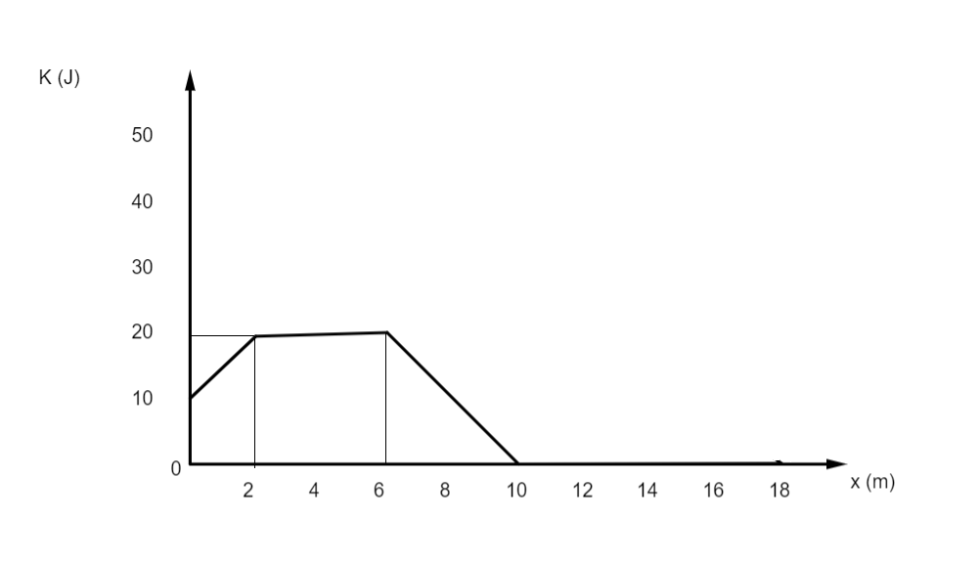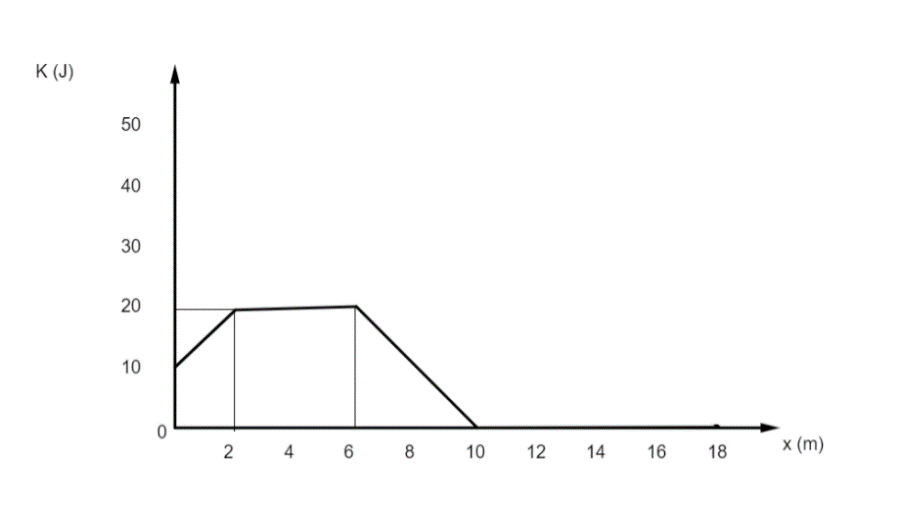
The kinetic energy $K$ of a particle moving along the x-axis varies with its position $\left( x \right)$ as shown in figure.

The magnitude of force acting on particle $x=9m$ is
$\begin{align}
& A)0N \\
& B)5N \\
& C)20N \\
& D)7.5N \\
\end{align}$

Answer
563.7k+ views
Hint: Here, the given graph is plotted between kinetic energy and displacement. From the graph, it is clear that kinetic energy is changing with respect to the displacement. By work-energy theorem, change in kinetic energy is equal to the work done. From this concept, we can find force, as work done is equal to the dot product of force and displacement.
Formula used:
$\begin{align}
& \Delta K=F.x \\
& W=F.x \\
\end{align}$
Complete answer:

From the given plot between kinetic energy and displacement, it is clear that when the displacement is $9m$, the kinetic energy is in its way from its maximum value to zero. From the work-energy theorem, we know that the change in kinetic energy is converted as the work done. Therefore, we can write:
$\Delta K=W$
where
$\Delta K$ is the change in kinetic energy
$W$is the work done
Let this be equation 1.
We also know that work done is equal to the dot product of force and displacement. Therefore, we have
$W=F.x$
where
$F$is the force acting on the body
$x$ is the displacement caused due to this force
Let this be equation 2.
From equation 1 and equation 2, we have
$\Delta K=F.x\Rightarrow F=\dfrac{\Delta K}{x}$
Let this be equation 3.
Now, from the given graph, it is clear that $\dfrac{\Delta K}{x}$ gives the slope of the slanting region.
Hence, by finding the slope, we can find the force acting on a particular point.
Clearly, force can be expressed as
\[F=slope=\dfrac{{{K}_{2}}-{{K}_{1}}}{{{x}_{1}}-{{x}_{2}}}\]
where
${{K}_{1}}=0J$ is the minimum kinetic energy, as clear from the graph
${{K}_{2}}=20J$ is the maximum kinetic energy, as clear from the graph
${{x}_{1}}=10m$ is the displacement corresponding to the minimum kinetic energy, as clear from the graph
${{x}_{2}}=6m$ is the displacement corresponding to maximum kinetic energy, as clear from the graph
Let this be expression 4.
Solving expression 4 by substituting the values given in graph, we have
$\begin{align}
& F=\dfrac{20J-0J}{10m-6m} \\
& F=\dfrac{20J}{4m} \\
& F=5N \\
\end{align}$
Hence, force acting from $6m$ to $10m$ is $5N.$
Therefore, at $x=9m$, the force is $5N$ .
The correct answer is option $B$.
Note:
In the equation $F=\dfrac{\Delta K}{x}$, students might have a tendency to take the displacement at $9m$. But this is not right, as it needs to be understood that the slope at any point
Formula used:
$\begin{align}
& \Delta K=F.x \\
& W=F.x \\
\end{align}$
Complete answer:

From the given plot between kinetic energy and displacement, it is clear that when the displacement is $9m$, the kinetic energy is in its way from its maximum value to zero. From the work-energy theorem, we know that the change in kinetic energy is converted as the work done. Therefore, we can write:
$\Delta K=W$
where
$\Delta K$ is the change in kinetic energy
$W$is the work done
Let this be equation 1.
We also know that work done is equal to the dot product of force and displacement. Therefore, we have
$W=F.x$
where
$F$is the force acting on the body
$x$ is the displacement caused due to this force
Let this be equation 2.
From equation 1 and equation 2, we have
$\Delta K=F.x\Rightarrow F=\dfrac{\Delta K}{x}$
Let this be equation 3.
Now, from the given graph, it is clear that $\dfrac{\Delta K}{x}$ gives the slope of the slanting region.
Hence, by finding the slope, we can find the force acting on a particular point.
Clearly, force can be expressed as
\[F=slope=\dfrac{{{K}_{2}}-{{K}_{1}}}{{{x}_{1}}-{{x}_{2}}}\]
where
${{K}_{1}}=0J$ is the minimum kinetic energy, as clear from the graph
${{K}_{2}}=20J$ is the maximum kinetic energy, as clear from the graph
${{x}_{1}}=10m$ is the displacement corresponding to the minimum kinetic energy, as clear from the graph
${{x}_{2}}=6m$ is the displacement corresponding to maximum kinetic energy, as clear from the graph
Let this be expression 4.
Solving expression 4 by substituting the values given in graph, we have
$\begin{align}
& F=\dfrac{20J-0J}{10m-6m} \\
& F=\dfrac{20J}{4m} \\
& F=5N \\
\end{align}$
Hence, force acting from $6m$ to $10m$ is $5N.$
Therefore, at $x=9m$, the force is $5N$ .
The correct answer is option $B$.
Note:
In the equation $F=\dfrac{\Delta K}{x}$, students might have a tendency to take the displacement at $9m$. But this is not right, as it needs to be understood that the slope at any point
Recently Updated Pages
Master Class 11 Economics: Engaging Questions & Answers for Success

Master Class 11 English: Engaging Questions & Answers for Success

Master Class 11 Social Science: Engaging Questions & Answers for Success

Master Class 11 Biology: Engaging Questions & Answers for Success

Class 11 Question and Answer - Your Ultimate Solutions Guide

Master Class 11 Business Studies: Engaging Questions & Answers for Success

Trending doubts
What is meant by exothermic and endothermic reactions class 11 chemistry CBSE

10 examples of friction in our daily life

One Metric ton is equal to kg A 10000 B 1000 C 100 class 11 physics CBSE

Difference Between Prokaryotic Cells and Eukaryotic Cells

What are Quantum numbers Explain the quantum number class 11 chemistry CBSE

1 Quintal is equal to a 110 kg b 10 kg c 100kg d 1000 class 11 physics CBSE




